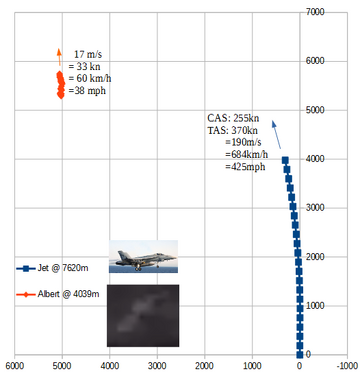Here's what my spreadsheet just spit out:

I haven't had the time to check the calculations properly yet, but at least it seems to pass some basic sanity checks, and seems to be a pretty good match to the earlier more coarse calculations that were done differently. The axes show distances in meters, as measured from the location and direction of the plane at 233 second mark of the video.
I collected all the available data from the video from 233s to 254s, so basically for all that time the rangefinder gave distance estimates. The problem was that the angles and distances shown in the video do not have enough precision for calculating the exact positions of Albert, who is moving too slowly and too far away relative to the rounding errors. When I did this with those raw numbers, Albert was moving within that same area, but zigzagging around due to the precision errors. I used several tricks to minimize those errors, but that still left Albert a bit jiggly path. That's just due to precision, my dear friend Albert is not a drunk flier!
The initial values I used varied Albert's flight altitude by close to a hundred meters or so, but that's unlikely to be real. I think it's reasonable to assume he was more likely to fly more or less level, so I put him at constant altitude, for which I believe I already had good estimates and reasoning in my original calculations on the first page. Those put him at 4020m. I fine-tuned that a bit and found that an altitude of 4039m resulted in correct rounded results for the calculated angles for all the steps as compared to the video. Even minor differences caused some of them to be rounded to the next number, so I think the altitude is actually pretty accurate (within instrument precision and actual altitude variations and so on). That way I could calculate the vertical camera angles from the altitude and rangefinder distances, which helped me to interpolate more accurate values for the distances (basically adding a digit or even two of precision), which is the most significant variable here.
In the video, the angles and distance estimates happen to change at a couple of points at more or less the exact same time the seconds change, meaning those values would most likely be just between the rounded numbers the display shows, and I used those between numbers moments as more accurate reference points for interpolating and fine-tuning the rest. I tweaked the numbers to higher precision so that they are all rounded correctly as compared to the video, and worked together so that there were no other similar rounding errors. I also used the rangefinder closing velocities to match the interpolated distance values, beginning with such reference points.
I calculated plane turn rates from the banking angles measured from the video according to the equation I mentioned before. I don't know how accurate they are for that type of jet, but hopefully close enough. I used the TAS speed for the jet, according to the calculator here:
Aviation Calculator
Remember that it also doesn't take winds into account. The absolute ground speeds or wind speeds relative to the ground do not really matter that much, but we basically just have to assume the winds were about the same for the altitudes of the jet and Albert, as I don't think we can get that information anywhere. If they weren't, the calculations would still be otherwise correct as they are measuring relative distances and speeds, but Albert just might have needed to do more or less work for achieving his relative speed than the figures indicate. If the winds were not too significant, it seems Albert wasn't flying close to his maximums but was just having a good time, cruising comfortably somewhere close to 60km/h=38mph, away from the nasty jet that was trailing behind, and then some creep hit his eye with a laser rangefinder

.
Note for those who haven't read my earlier messages: that pic of Albert above in the chart is an actual enlarged screenshot of him from the Washington Post video here:
Perspective | The military keeps encountering UFOs. Why doesn’t the Pentagon care?
 .
.

 .
.